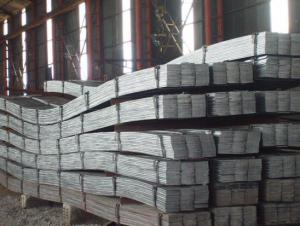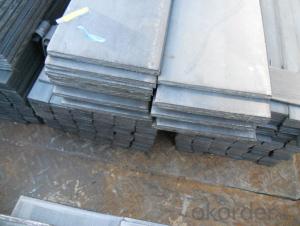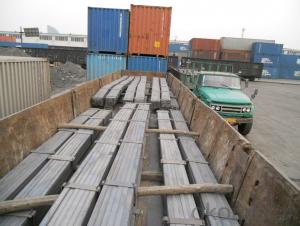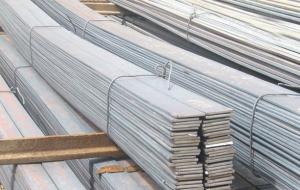Flat Bar Iron Steel Slitted
- Loading Port:
- China Main Port
- Payment Terms:
- TT or LC
- Min Order Qty:
- 100 m.t.
- Supply Capability:
- 10000 m.t./month
OKorder Service Pledge
OKorder Financial Service
You Might Also Like
OKorder is offering Flat Bar Iron Steel Slitted at great prices with worldwide shipping. Our supplier is a world-class manufacturer of steel, with our products utilized the world over. OKorder annually supplies products to African, South American and Asian markets. We provide quotations within 24 hours of receiving an inquiry and guarantee competitive prices.
Product Applications:
Flat Bar Iron Steel Slitted are ideal for structural applications and are widely used in the construction of buildings and bridges, and the manufacturing, petrochemical, and transportation industries.
Product Advantages:
OKorder's Flat Bar Iron Steel Slitted are durable, strong, and wide variety of sizes.
Main Product Features:
· Premium quality
· Prompt delivery & seaworthy packing (30 days after receiving deposit)
· Can be recycled and reused
· Mill test certification
· Professional Service
· Competitive pricing
Product Specifications:
Commodity: Mild Steel Flat Bar
Standard: GB;JIS
Material: Q195-235;SS400
Origin place: China
Thickness: 3mm-30mm
Width:20mm-200mm
Length: Max 12m
Certification: SGS/BV
Packaging: Export packing, nude packing, bundled
Alloy No | Grade | Element(%) | ||||
C
| Mn
| S
| P
| Si
| ||
Q235
|
B
|
0.12—0.20 |
0.3—0.7 |
≤0.045 |
≤0.045
|
≤0.3
|
Alloy No | Grade | Yielding strength point(Mpa) | Tensile strength (Mpa) | Elongation after fracture(%) | ||||||
Thickness (mm) | Thickness (mm) | |||||||||
≤16 | >16--40 | >40--60 | >60--100 | ≤16 | >16--40 | >40--60 | >60--100 | |||
≥ | ≥ | |||||||||
Q235 |
B |
235 |
225 |
215 |
205 |
375--500 |
26 |
25 |
24 |
23 |
FAQ:
Q1: Why buy Materials & Equipment from OKorder.com?
A1: All products offered byOKorder.com are carefully selected from China's most reliable manufacturing enterprises. Through its ISO certifications, OKorder.com adheres to the highest standards and a commitment to supply chain safety and customer satisfaction.
Q2: How do we guarantee the quality of our products?
A2: We have established an advanced quality management system which conducts strict quality tests at every step, from raw materials to the final product. At the same time, we provide extensive follow-up service assurances as required.
Q3: How soon can we receive the product after purchase?
A3: Within three days of placing an order, we will arrange production. The normal sizes with the normal grade can be produced within one month. The specific shipping date is dependent upon international and government factors, the delivery to international main port about 45-60days.
Images:


- Q: Can steel flat bars be galvanized or coated with other materials?
- Steel flat bars can undergo galvanization or be coated with alternative materials. Galvanization involves applying a zinc protective layer to prevent corrosion. This can be accomplished through hot-dip galvanization, where the steel is immersed in molten zinc, or electroplating, which applies a zinc coating using an electrochemical process. In addition to galvanization, alternative materials can be used to coat steel flat bars for various purposes. These coatings offer extra corrosion protection, enhance the steel's appearance, or improve specific properties. Common coating materials for steel flat bars include epoxy, polyurethane, powder coating, and paint. The application methods vary, such as spraying, dipping, or powder coating, depending on specific requirements and desired outcomes. The choice of coating material and method relies on factors like the intended use, the environment of use, and desired appearance or performance characteristics. It is crucial to consult experts or professionals in the field to determine the most suitable coating option for individual needs.
- Q: Are steel flat bars susceptible to warping or twisting?
- Under certain conditions, steel flat bars can warp or twist. This can happen due to factors like uneven heating or cooling during manufacturing, improper handling or storage, excessive stress during use, or if the bars are of low quality or have structural defects. Proper handling and storage of steel flat bars is crucial to avoid situations that could cause excessive stress or uneven heating/cooling. Regular inspections and maintenance can help detect signs of warping or twisting early on, enabling preventive measures to be taken to avoid further damage.
- Q: What is 40x4 galvanized flat steel, please?
- Main application: galvanized flat steel is used as material, used for making iron, tools and machinery parts. It is used as frame, structure and escalator for building.
- Q: Where is the use of flat steel in electrical use?
- The flat steel used in the project consists of two types: galvanized and non galvanized. Galvanized is mainly used in decorative materials and pipes, such as rings, hoop and so on;
- Q: Are steel flat bars used in the construction of bridges?
- Yes, steel flat bars are commonly used in the construction of bridges. Flat bars, also known as flat steel, are often utilized as structural components in bridge construction due to their strength, durability, and versatility. These bars are typically made from carbon steel, which provides the required strength to support the weight and load of the bridge. Steel flat bars are used in various bridge components, including beams, trusses, and decking. They are often incorporated into the structural framework to distribute the load and provide stability, ensuring the bridge's overall integrity. Additionally, steel flat bars are highly resistant to corrosion, making them suitable for outdoor applications where bridges are exposed to environmental elements. Overall, steel flat bars play a crucial role in the construction of bridges, contributing to their strength, stability, and longevity.
- Q: Can steel flat bars be used for making brackets or mounting hardware?
- Indeed, brackets or mounting hardware can be fashioned using steel flat bars. Steel boasts exceptional strength and durability, rendering it a perfect substance for crafting robust brackets and mounting hardware. Steel flat bars are malleable, easily tailored, severed, and fused to meet precise specifications, while their flat exterior furnishes a steady foundation for mounting diverse elements. Furthermore, steel's corrosion resistance guarantees the longevity and unfaltering performance of the brackets or mounting hardware.
- Q: Are steel flat bars suitable for making machinery frames or chassis?
- Yes, steel flat bars are commonly used in the construction of machinery frames or chassis due to their strength, durability, and ability to withstand heavy loads. They provide excellent structural support and can be easily welded or bolted together to create a sturdy and reliable frame or chassis for various types of machinery.
- Q: Are steel flat bars resistant to impact?
- Generally speaking, steel flat bars possess resistance to impact. Steel, renowned for its remarkable tensile strength and durability, can endure substantial force and impact without deformation or fracture. Notably, steel flat bars find wide application in construction, manufacturing, and fabrication, particularly in scenarios necessitating impact resistance. Nevertheless, it is imperative to acknowledge that the impact resistance of steel flat bars may fluctuate based on variables like steel grade, bar thickness, and particular usage conditions.
- Q: Can steel flat bars be used in agricultural applications?
- Yes, steel flat bars can be used in agricultural applications. They are commonly used for constructing fences, gates, and farm equipment due to their durability and strength.
- Q: 80 * 80 * 4 galvanized flat steel is what specifications?
- Galvanized square is a hot-rolled or cold-rolled galvanized steel or galvanized sheet for the blank shape by the cold bending process after section steel pipe welded square hollow square cross-section shape and size of the high-frequency; or the cold hollow steel well in advance of the re galvanized square by galvanizing processing of pipe.
Send your message to us
Flat Bar Iron Steel Slitted
- Loading Port:
- China Main Port
- Payment Terms:
- TT or LC
- Min Order Qty:
- 100 m.t.
- Supply Capability:
- 10000 m.t./month
OKorder Service Pledge
OKorder Financial Service
Similar products
Hot products
Hot Searches
Related keywords





























